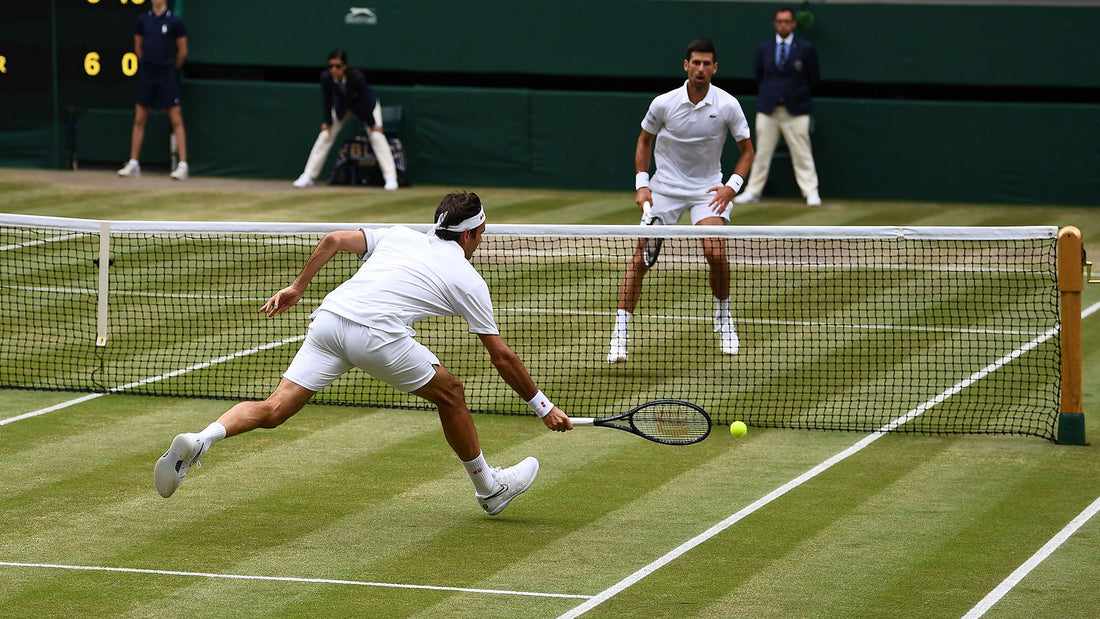
The different styles of tennis play to guide your choice of equipment
Share
The Tenniszon team presents in this article the different styles of tennis play in order to guide the choice of your equipment, more specifically the racket and the stringing. It is interesting to note that the styles that will be described often guide the design of the equipment series produced by the manufacturers. For example, Babolat produces three series of racquets that are distinguished by specific characteristics closely related to the style of play, namely power (Pure Drive), spin (Pure Aero) and control (Pure Strike).
The main styles described in this article:
- Aggressive baseliner
- Counterpuncher
- All-Court player
- Serve and volley
Aggressive baseliner
The baseliner style has become the dominant style in modern tennis. This style is indeed the most represented on the professional circuits, largely due to the evolution of rackets, strings (notably polyester/co-polyester which offers a lot of snapback) and playing surfaces. Playing from the baseline but close to the baseline, the striker distinguishes himself by his powerful and often tightly angled shot, putting a lot of spin on the ball. This rotation causes the ball to stay in the air longer and then drop abruptly to the ground, making it harder for the opposing player to judge the ball and allowing him to put a lot of power into the shot while keeping the ball in play. This power and search for angles has the effect of opening" the field and then allowing a power shot into the opening. Among professionals, the most convincing examples are Rafael Nadal, Serena Williams and closer to us, Felix Auger-Aliassime and Bianca Andreescu. Before them, Jimmy Connors (in a different form - he played more flat), Ivan Lendl, Andre Agassi and Monica Seles also practiced this style.
Recommended optimal equipment
- Racquet : Spin oriented. Ex: Babolat Pure Aero, Head Extreme, Dunlop SX.
- String : Co-Polyester string
- Tension: 50-55 lbs
Counterpuncher
A common style among amateur players, the Counterpuncher style is characterized by a more defensive player, who mainly plays a few feet behind the baseline and who advocates patience in order to force an opponent's error or to wait for an opening. This style leads to longer exchanges and requires excellent mobility, especially at a high level. The counterpuncher often excels at returning serves and counterattacking, while using a flatter ball. When it comes to equipment, the counterpuncher looks for a racquet that provides power, as the distance and length of exchanges quickly becomes exhausting. His racquet must therefore allow him to compensate for this fatigue, in addition to challenging the opponent with powerful and deep strokes. These players are also looking for rackets that offer more stability to reduce vibration during defense and counter-attack. Examples of professional players include Bjorn Borg, Michael Chang, Lleyton Hewitt, Gaël Monfils, Simona Halep and Elina Svitolina.
Recommended optimal equipment
- Racquet : Power oriented. Ex: Babolat Pure Drive, Yonex Ezone, Wilson Ultra.
- String : Multifilament or natural gut strings for more power and comfort, co-polyester for more control
- Tension: 50-55 lbs co-polyester and 55-60 lbs gut/multifilament
All-Court Player
The all-around player is able to adapt to all styles of play and use the most appropriate style to counter the opponent. All-rounders are usually advanced players with excellent technique at the net and on the baseline, as well as an efficient serve. Although some racquets are more versatile than others, a complete player can use almost any model. Among the pros, we find Steffi Graf, Boris Becker, Roger Federer, Andy Murray, Novak Djokovic, Ashley Barty, Denis Shapovalov and Daniil Medvedev.
Recommended optimal equipment
- Racquet : Versatile. Ex: Wilson Clash, Head Speed, Yonex VCore, Tecnifibre T-Fight, Babolat Pure Strike
- String : Hybrid string, natural gut/synthetic gut/multifilament and co-polyester
- Tension: 50-55 lbs co-polyester and 55-60 lbs gut/multifilament
Serve and volley
The serve-and-volley style is the oldest style in tennis, in part because originally, wooden rackets did not allow for much power and spin. Players had to build points from the start by forcing the opponent to defend from the very beginning of the point. This style requires an excellent first serve that is difficult for the opponent to return, either because of its power or because of its spin. Less used today, especially because of the evolution of racquet materials and the improvement of the return of serve from the current generation of players, this style still has its followers. Moreover, it is still the preferred strategy for intermediate and above level doubles players. Current and former professionals include Rod Laver, John McEnroe, Stefan Edberg, Pete Sampras, Martina Navratilova, John Isner and Karolina Pliskova.
Recommended optimal equipment
- Racquet : Control oriented. Ex: Wilson Pro Staff, Head Prestige, Babolat Pure Strike, Yonex VCORE Pro.
- Strings : Natural/synthetic gut or multifilament. Co-polyester also possible.
- Tension: 55-60 lbs
In conclusion, it is important to note that no player (or very rarely) plays 100% in one category, although all players tend to favor one style depending on their preferences and abilities. There are many racquets that are hybrids between different styles to allow players to balance their game (e.g. Head Gravity, Head Radical, Wilson Blade). While it is not necessary to have specific equipment for a particular style of play, being aware that one's equipment is better suited to certain styles can certainly provide benefits and guide the choice of a racquet that supports and promotes the strengths of one's game.